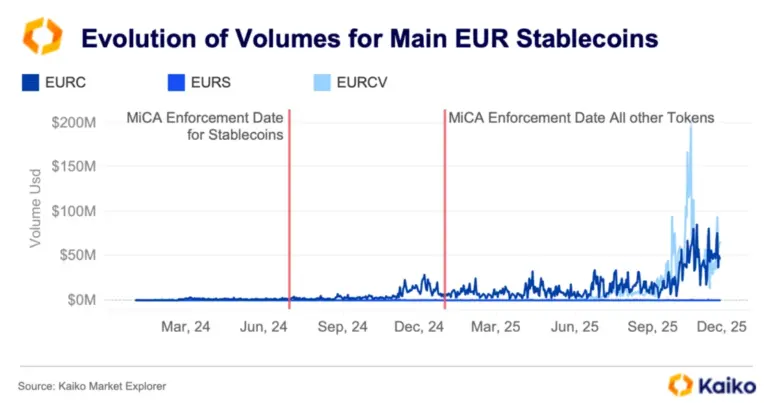Data Points
EIGEN token unlock sparks concerns.
EigenLayer’s anticipated token unlock last week wasn’t without controversy. While initial airdrop claims went live in May the tokens weren’t transferable until now.
The price of EIGEN debuted around $4 last Tuesday and has since fallen 20% to trade around $3.30. The decline had slowed between Thursday and Friday before scrutiny of the protocol’s airdrop drew suspicion and an “erroneous” transfer sparked uncertainty. A statement from the EigenLayer team appears to have done little to address concerns, with prices falling throughout the week.
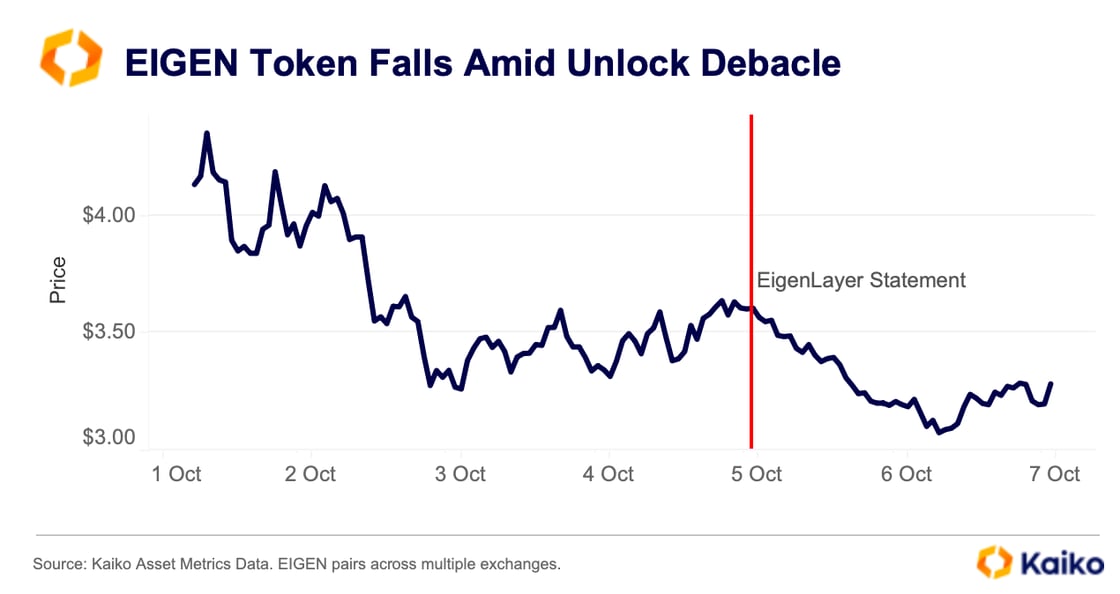
A transfer of $5.5mn worth of EIGEN on Friday raised concerns that someone close to the protocol—a current or former employee, or even an early investor—had violated the lockup schedule.
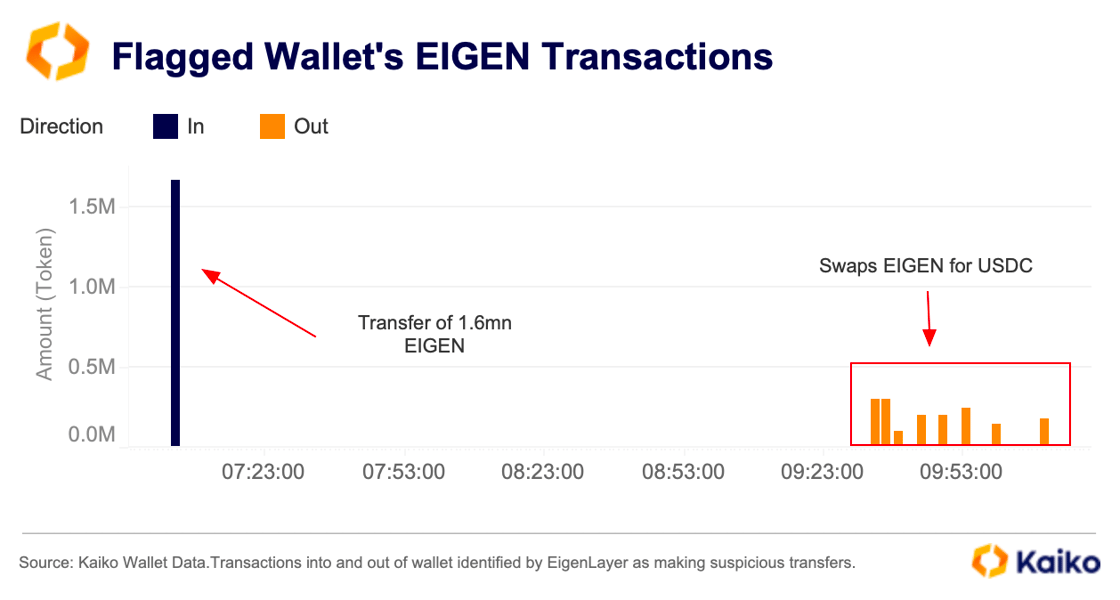
EigenLayer confirmed that it was an “isolated incident” on Friday. A malicious attacker compromised an email related to an investor’s transfer of tokens into custody, the team said. This resulted in over 1.6mn EIGEN being transferred to the attacker. The fumbled unlock has weighed on the token price and is an example of the high stakes during a token generating event.
Ethena becomes latest protocol to leverage BUIDL.
BlackRock’s continues to see demand for its on-chain tokenized fund BUIDL, or the BlackRock USD Institutional Digital Liquidity Fund. With over $530mn in assets under management it is the largest tokenized money market fund in the world.
As well as consistent inflows there have also been some high profile integrations with BUIDL since launching in March. Ondo Finance and Mountain Protocol use BUIDL to back their own yield bearing products, showcasing the traditional finance giant’s growing role in the digital assets space.

Most recently Ethena announced plans to launch a stablecoin backed by BUIDL, USDt. The backing is in partnership with Securitize, who BlackRock worked with to launch its fund in March.
Ethena’s new stablecoin will be separate from its USDe offering. Having a stablecoin backed by BUIDL will help the Ethena mitigate risk in negative funding rate environments, allowing USDe to benefit from the stability of USDt.
FTX to launch creditor repayments.
Nearly two years after FTX’s collapse, the exchange is seeking court approval for its liquidation plan today. The plan aims to repay 98% of customers in cash within 60 days of approval, based on November 2022 asset values.
As of last year, FTX’s bankruptcy estate has recovered nearly $4 billion in digital assets and received authorization to start selling some of its holdings in September 2023. The estate’s recovery has benefited from a rebound in crypto prices since November 2022, with key holdings such as SOL, TON, and TRX more than doubling in value.
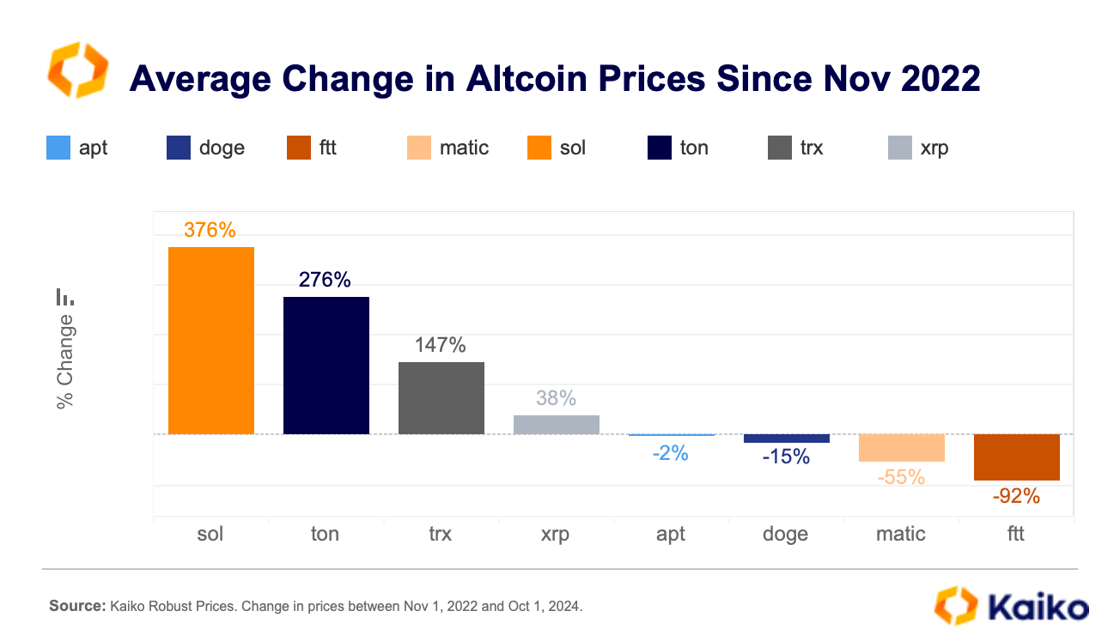
The 1% market depth for FTX’s top assets, which include SOL, DOGE, TON, TRX, BIT, XRP, and the native FTT token, surged from $80 million to over $200 million, enabling larger sales without significant price disruptions.
FTX also held several smaller and less liquid tokens, some of which have almost no market value. These include tokens like Oxygen (OXY) and Maps (MAPS), which are particularly problematic for the estate due to FTX’s overwhelming ownership. The exchange held 99% of MAPS tokens, 97% of OXY tokens, and 95% of Serum (SRM) tokens.
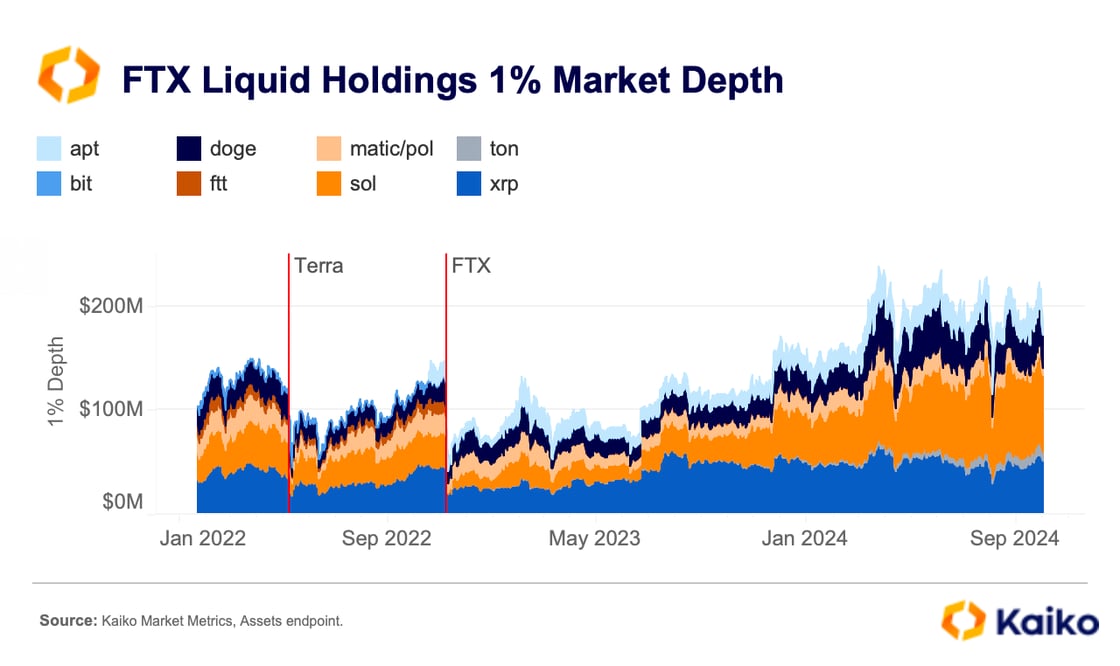
Given FTX’s dominant position in these assets, any attempt to sell them would likely have caused their prices to collapse to zero almost immediately. Consequently, the FTX bankruptcy estate has applied steep discounts to their valuation. MAPS tokens are considered worthless, OXY tokens face a 99.9% discount, and SRM tokens are discounted by 18.6% due to liquidity issues. Other assets, like BRC, BRLT, and BTRN, are valued at zero since they’re no longer traded.
Privacy tokens face record delistings in 2024.
Privacy tokens, designed for anonymous transactions, continue to face mounting regulatory pressure. Last week, Kraken announced it would delist Monero (XMR) for European users, causing a 9% drop in XMR prices. This follows similar actions by exchanges like OKX, Binance, and Huobi. Countries such as South Korea, Japan, and Australia have also banned or restricted these tokens over concerns about money laundering and consumer protection.
Delistings of top privacy tokens—Zcash, Monero, Dash, DCR, ROSE, and MASK—have surged, peaking in 2024, with Monero experiencing a six-fold increase in delistings this year.
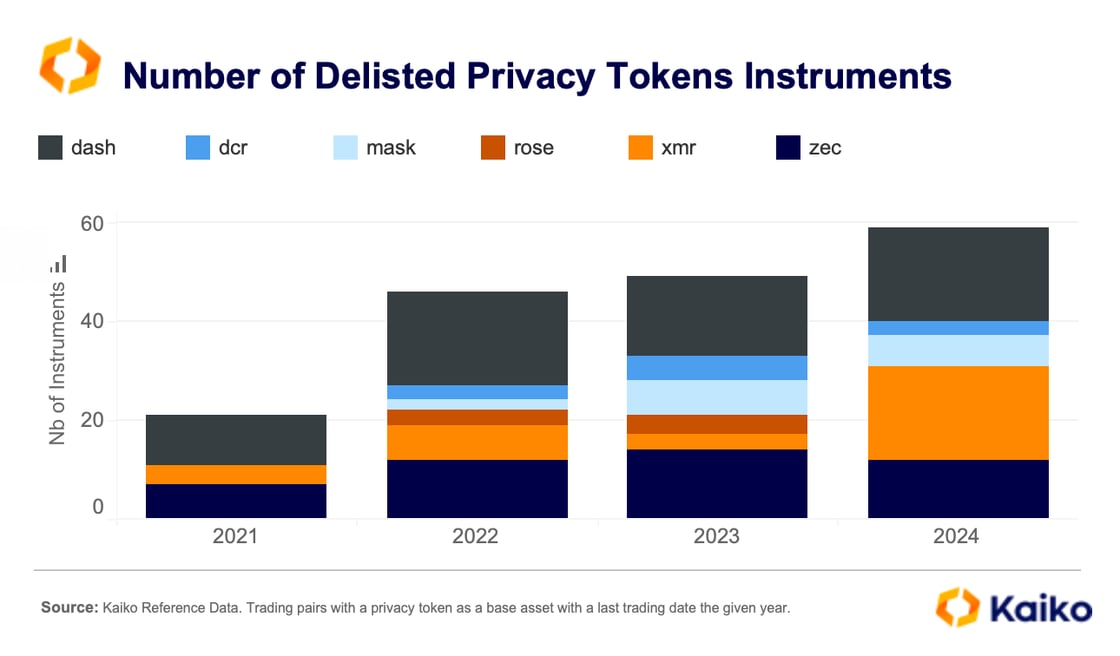 As a result, trading activity for these tokens has shifted to less regulated platforms. Poloniex and the Russia-linked platform Yobit now account for about 40% of the trading volume for top privacy tokens, up from just 18% in 2021.
As a result, trading activity for these tokens has shifted to less regulated platforms. Poloniex and the Russia-linked platform Yobit now account for about 40% of the trading volume for top privacy tokens, up from just 18% in 2021.
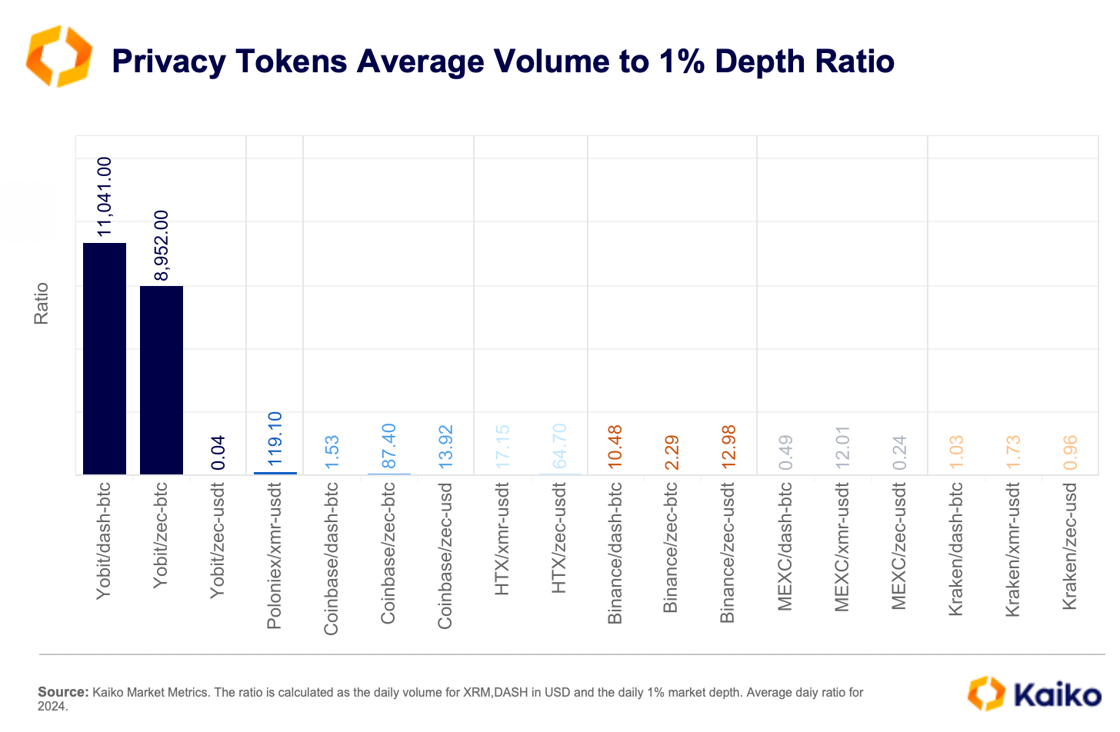 The trading volumes on these exchanges often exceed actual order book liquidity, as indicated by the daily volume-to-1%-market-depth ratio, suggesting possible suspicious trading activity. On Yobit, the average daily trade volume for top privacy token trading pairs was more than 11,000 times higher than the 1% market depth, and on Poloniex, it was 119 times higher.
The trading volumes on these exchanges often exceed actual order book liquidity, as indicated by the daily volume-to-1%-market-depth ratio, suggesting possible suspicious trading activity. On Yobit, the average daily trade volume for top privacy token trading pairs was more than 11,000 times higher than the 1% market depth, and on Poloniex, it was 119 times higher.
Uncertainties keep Japanese traders on the sidelines.
After decades of stability, the Japanese Yen (JPY) has entered a period of volatility this year as the Bank of Japan (BoJ) began to normalize its monetary policy. The yen hit a seven-month high following the BoJ rate cut in August but has since lost some of those gains. This recent decline is attributed to dovish remarks from newly appointed Prime Minister Shigeru Ishiba, strong U.S. economic data, and rising geopolitical tensions.

This volatility has also affected cryptocurrency markets, with the 90-day volatility of BTC-JPY surging sharply in August, surpassing that of BTC-USD for the first time since July 2022.
Despite a recent rally in crypto prices, this uncertainty has kept traders away from the crypto market. Japanese trading volume has remained flat at around $200 million daily since August, half the January-July average of $400 million. In contrast, trading volumes on US and Korean exchanges have increased in September as sentiment turned more bullish.


![]()
![]()
![]()
![]()




.png?upscale=true&width=1120&upscale=true&name=Screenshot%202024-10-07%20at%2014.31.09%20(1).png)








 As a result, trading activity for these tokens has shifted to less regulated platforms. Poloniex and the Russia-linked platform Yobit now account for about 40% of the trading volume for top privacy tokens, up from just 18% in 2021.
As a result, trading activity for these tokens has shifted to less regulated platforms. Poloniex and the Russia-linked platform Yobit now account for about 40% of the trading volume for top privacy tokens, up from just 18% in 2021. The trading volumes on these exchanges often exceed actual order book liquidity, as indicated by the daily volume-to-1%-market-depth ratio, suggesting possible suspicious trading activity. On Yobit, the average daily trade volume for top privacy token trading pairs was more than 11,000 times higher than the 1% market depth, and on Poloniex, it was 119 times higher.
The trading volumes on these exchanges often exceed actual order book liquidity, as indicated by the daily volume-to-1%-market-depth ratio, suggesting possible suspicious trading activity. On Yobit, the average daily trade volume for top privacy token trading pairs was more than 11,000 times higher than the 1% market depth, and on Poloniex, it was 119 times higher.



